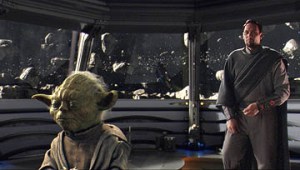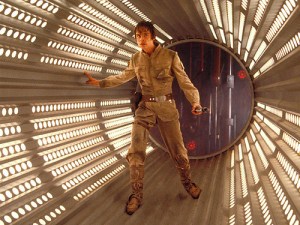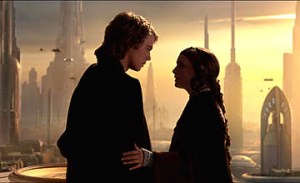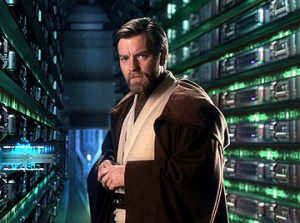(My new contribution to Edward Copeland’s Star Wars Blog-a-thon. I also offered old essays on George Lucas’ endless tinkering and Revenge of the Sith.)
 Is it possible that the failure of the second Star Wars trilogy has nothing to do with plot, character, and storytelling and everything to do with physical space?
Is it possible that the failure of the second Star Wars trilogy has nothing to do with plot, character, and storytelling and everything to do with physical space?
Think of it this way: George Lucas was intimately involved in both trilogies, and they share certain negative characteristics: rote acting, rote writing, coarse storytelling. And consider: The key performers in the newer trilogy, even giving subpar turns, are easily better actors than Mark Hamill, Carrie Fisher, and Harrison Ford. The main difference between the trilogies is technological, in particular the replacement of physical special effects – models, composite shots, actors in front of filmed backgrounds – with digital. And most critical is the substitution of digital backgrounds for decorated-set and location shooting.


This gut feeling could be a function of age and familiarity as much as reality. I was six when Star Wars came out in 1977 and saw the movie eight or nine times in its initial release. I was 34 when Revenge of the Sith hit screens, and I haven’t seen any of the latter trilogy more than once. I was the target market for the first trilogy, and too damned old for the second.
Still, as I thought about The Empire Strikes Back, my epiphany was the vividness of three locations: Hoth, Dagobah, and Cloud City. In the original trilogy, Death Star interiors and Jabba’s lair are similarly seared into my memory. I can not only see these places, but I have an acute sense of their layout and can nearly envision myself in them.
In the newer trilogy, I can’t recall the details of a single place.


Settings are critical to the success or failure of science fiction and fantasy. Movie patrons have an obligation to suspend their disbelief, but filmmakers have a duty to facilitate that suspension and remove barriers to it. Convincing details sell a story, and the easiest way to help people immerse themselves in a foreign place is to help them feel like they’re there.
And this is where Lucas fails in the “prequel” trilogy. The worlds he has created are more visually luminous, and more striking, and infinitely detailed, but they’re less real, and they don’t have any physicality. They’re missing the third dimension, and that creates a barrier to immersion. They lack the force of tangibility.
On a practical level, this makes perfect sense. To film on a set, you need a set, and it needs to be not only conceived but planned and executed. Artistic renderings. Architectural drawings. Decisions about materials. Construction. Decoration. With digital backgrounds, filmmakers can skip several of those steps, and the result is often more whimsical – and not in the “fanciful” sense.
The need for less planning leads to fewer choices being made during filming than with a physical backdrop. And that means that the choreography of a given scene will be more generic, and less tied to a specific location, further divorcing the movie from a physical reality.
Even if we assume that professional actors are fully capable of engaging in a scene when the setting (and sometimes their co-stars) will be added later, the audience is still aware subconsciously of the failure to create a genuine place.


I think you may be on to something. I can’t recall much specific from the second trilogy outside of the Senate chamber, and that was more because of spectacle than detail. I do have to differ with you on one aspect though: I think the acting ensembles are about evenly matched because while Hamill and Fisher were weak, Ford was great and they also had Alec Guinness, Peter Cushing, Billy Dee Williams and the voice of James Earl Jones. Of course, one of his very best casting decisions (Ian McDiarmid) bridged both trilogies.
I was referring, mostly, to the leads: Ewan McGregor, Natalie Portman, and Hayden Christensen compared to Ford, Fisher, and Hamill.
But still: Point taken.
“Artistic renderings. Architectural drawings. Decisions about materials. Construction. Decoration. With digital backgrounds, filmmakers can skip several of those steps…”
No they can’t! I’m in fundamental agreement about the weightless slippiness of digital environments – and creatures, spaceships and people – but CG work is painstaking to create as a hand-animated film, and as much design labor goes into virtual sets as physical sets. Two possible problems of digital environments that enforce the sense of unreality: actors cannot choose to interact with the space, and the necessity of building out every object, and physical event eliminates accident. The physics are custom-built, so a CGI-set PLAN NINE FROM OUTER SPACE could never have a window slam shut mid-scene.
I don’t dispute that much work goes into creating digital environments, and I don’t claim that less work goes into digital environments.
But I think it’s a different type of work, one with less sensitivity to all the elements that make up a place. You can make it look good, and you can make it look as real as a regular set, but it still can’t be a physical, three-dimensional set, and it can’t yet convincingly mimic it, either.
The analogy I’d use is comparing an actual house to a painting of a house. They are very different objects.
Am I wrong? I’ve been wrong before … .
great article. we actually approached the same topic only I thank you for explaining it in better detail 😉 although I think the later films are more poorly written, too. Not only are the physical spaces too detailed but everything is too detailed. there’s no room for the audiences inside of all the exposition and explanation (midichlorians hurt my heart –i can’t even bear to watch the prequels)
Nathaniel R refers to his own article, which is part of his tremendously entertaining and enlightening 20:07 series.
I know of at least one filmmaker–a great one–who insists that he has no idea what the scene should look like or how the actors should move or what kind of movements the camera should make–if any–until he’s actually seen the setting. I think that tends to support your theory.
This is a great thread. I completely agree with the premise that using virtual sets can put a film at a disadvantage, and I think this is particularly true of The Phantom Menace: the actors were clearly in a vacuum. However, by Episode III, I think that Lucas (and the actors) have gotten quite good at this CGI background thing… I was shocked to learn that there were practically no physical sets in that one, even the smallest spaces were digitally created. I was also surprised to learn that all of the clone troopers were digital, even the ones in closeup interacting with the flesh and blood actors.
I guess I somewhat agree with this. I think the bigger problem is that George Lucas placed more importance on the “wow” factor of actually shooting the whole thing digitally than script writing or direction. The lack of substance to the sets is just a symptom of the bigger problem that Lucas’ priorities were all out of whack.
Is that a change from Episode IV?
I return to the idea that constraints stimulate creativity, and I think the reason the first of the Lucas-directed movies works better than the others is the technological/special-effect limits of the time. When everything became available to him, he got lazier.
“Is it possible that the failure of the second Star Wars trilogy has nothing to do with plot, character, and storytelling and everything to do with physical space?”
The “failure” of the second Star Wars trilogy? As I recall, it didn’t fail. From whose viewpoint are you speaking for? Yours? Because you’re certainly not speaking for me. And I’ve been a STAR WARS fan for a long time.
This entire article is bullshit.
[“Is it possible that the failure of the second Star Wars trilogy has nothing to do with plot, character, and storytelling and everything to do with physical space?”]
FAILURE? What failure? All three movies were box office hits. And the Prequel Trilogy has a very large fan base, regardless of whether you want to believe this or not.
Failure? Jeez Louise! I never heard of anything so ridiculous in my life. Please try not to presume to project your own feelings about these films upon the fandom at large.
I despise the “TRANSFORMERS” movies. But I don’t go around pretending that the franchise has a large fan base.